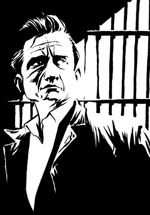 Comics are increasingly read as bits and bytes, on PCs and handheld devices.
Comics are increasingly read as bits and bytes, on PCs and handheld devices.
Blank creators Brothers of the Silence are publishing the comic in Flash on their site, and as image files on Facebook and several other sites. “Brothers” Ian LeWinter and Don Richmond talk about creating the comic and promoting it via social media sites.
Dale Wilson of DWAP Productions, making his second appearance on this podcast, discusses the ways his company is getting its traditional paper product out in handheld device formats.
Remember “Yon Kuma”? Tim and Mulele reviewed it a year ago. It’s now called “Bear Beater Bunyan,” and it’s an iPhone app. Artist Jorge Munoz talks about the path he and writer Josh Hechinger followed in making the comic available for handhelds.
“Bear Beater Bunyan” is just one of many comics available from Robotcomics.net. Robot Comics Deputy Director Dave Baxter fills us in on the state of the growing comics market for handhelds and how Robot does what it does.
Finally, Tim and Mulele review some of Robot’s output.
Podcast: Play in new window | Download

 Tim and Mulele review two Web comics that have little in common besides the nationality of their creators!
Tim and Mulele review two Web comics that have little in common besides the nationality of their creators!  Though Asterios Polyp made the point that comics and (written) music are similar, doing a comic about music is not such an easy task. But Reinhard Kleist beautifully presents the music, and life, of a country music legend in Johnny Cash: I See a Darkness, recently released in English. How does it compare with the Cash biopic Walk the Line? Tim and Paul review.
Though Asterios Polyp made the point that comics and (written) music are similar, doing a comic about music is not such an easy task. But Reinhard Kleist beautifully presents the music, and life, of a country music legend in Johnny Cash: I See a Darkness, recently released in English. How does it compare with the Cash biopic Walk the Line? Tim and Paul review. If you think the area where you live is too isolated and lacks a comics scene, consider the Pacific island of Guam: Fewer than 200,000 people, only about half of whom use the Internet. Few comics outlets, and a small selection. And even
If you think the area where you live is too isolated and lacks a comics scene, consider the Pacific island of Guam: Fewer than 200,000 people, only about half of whom use the Internet. Few comics outlets, and a small selection. And even  Reviews of Asterios Polyp blanket the Internet; why need we pile on? Well, for starters, to counteract all the reviewers who think that giving a story synoposis = explaining what the book’s about. That approach falls far short with Polyp, so Tim and Kumar are here to explain what they feel David Mazzucchelli’s masterwork graphic novel is really about!
Reviews of Asterios Polyp blanket the Internet; why need we pile on? Well, for starters, to counteract all the reviewers who think that giving a story synoposis = explaining what the book’s about. That approach falls far short with Polyp, so Tim and Kumar are here to explain what they feel David Mazzucchelli’s masterwork graphic novel is really about! Is having your work illegally downloaded the worst thing that can happen to a comics artist? If you work for a major, perhaps not, but every download can have a noticeable effect when you’re trying to make a living drawing comics that are less widely purchased. One such freelancer,
Is having your work illegally downloaded the worst thing that can happen to a comics artist? If you work for a major, perhaps not, but every download can have a noticeable effect when you’re trying to make a living drawing comics that are less widely purchased. One such freelancer,  A recent Comics Reporter
A recent Comics Reporter 
 Australia is not world-renowned for its comics scene. But Perth-based
Australia is not world-renowned for its comics scene. But Perth-based  Tim and Mulele are joined by
Tim and Mulele are joined by  Then Tim and Mulele discuss two books by Ken Dahl, “Welcome to the Dahl House” and “Monsters”.
Then Tim and Mulele discuss two books by Ken Dahl, “Welcome to the Dahl House” and “Monsters”.